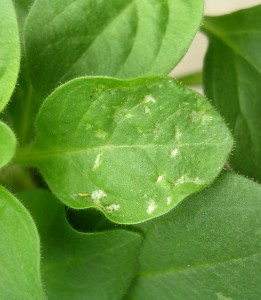Impatiens Necrotic Spot Virus
go.ncsu.edu/readext?366630
en Español / em Português
El inglés es el idioma de control de esta página. En la medida en que haya algún conflicto entre la traducción al inglés y la traducción, el inglés prevalece.
Al hacer clic en el enlace de traducción se activa un servicio de traducción gratuito para convertir la página al español. Al igual que con cualquier traducción por Internet, la conversión no es sensible al contexto y puede que no traduzca el texto en su significado original. NC State Extension no garantiza la exactitud del texto traducido. Por favor, tenga en cuenta que algunas aplicaciones y/o servicios pueden no funcionar como se espera cuando se traducen.
Português
Inglês é o idioma de controle desta página. Na medida que haja algum conflito entre o texto original em Inglês e a tradução, o Inglês prevalece.
Ao clicar no link de tradução, um serviço gratuito de tradução será ativado para converter a página para o Português. Como em qualquer tradução pela internet, a conversão não é sensivel ao contexto e pode não ocorrer a tradução para o significado orginal. O serviço de Extensão da Carolina do Norte (NC State Extension) não garante a exatidão do texto traduzido. Por favor, observe que algumas funções ou serviços podem não funcionar como esperado após a tradução.
English
English is the controlling language of this page. To the extent there is any conflict between the English text and the translation, English controls.
Clicking on the translation link activates a free translation service to convert the page to Spanish. As with any Internet translation, the conversion is not context-sensitive and may not translate the text to its original meaning. NC State Extension does not guarantee the accuracy of the translated text. Please note that some applications and/or services may not function as expected when translated.
Collapse ▲Impatiens necrotic spot virus (INSV) affects ornamental greenhouse crops like impatiens and mums but also many vegetables and herbs. The virus can infect over 200 plant species. It is a lethal virus spread by thrips feeding. Managing INSV is critical because it can easily over run your crop and cause you long-term problems. Thrips become infected with the virus while feeding as larvae. After they pupate thrips spread the virus to new plants when they feed as adults.
Thus, INSV management starts with thrips management. The essence is to start with sanitation. Thrips can feed on hundreds of plants so any weeds growing in or near your greenhouse can support thrips feeding and egg laying. Get rid of pet plants and mother plants. Maybe you or you grandmother want to overwinter last years peppers or begonias but don’t. Its not worth it. These can serve as reservoirs for thrips and virus and keep your house constantly infected.
If you have INSV in the greenhouse get rid of all plants that show symptoms and consider getting rid of all plants with thrips damage. Plants do not immediately show symptoms but they can still infect thrips. So even if you get rid of plants with visible INSV spots thrips may continue to get infected from asymptomatic plants and spread the virus. Manage thrips with insecticide applications or ramp up an existing biological control program to get thrips under control. Keep an eye out for tell tale rings and spots on leaves so you can keep ahead of this virus and of course monitor for thrips with sticky cards to keep ahead of them.
You can read more about thrips management in an Insect Note and recent article in GrowerTalks.
If you would like to see thrips defend themselves from predatory mites by butt slappin’ them watch the video.



